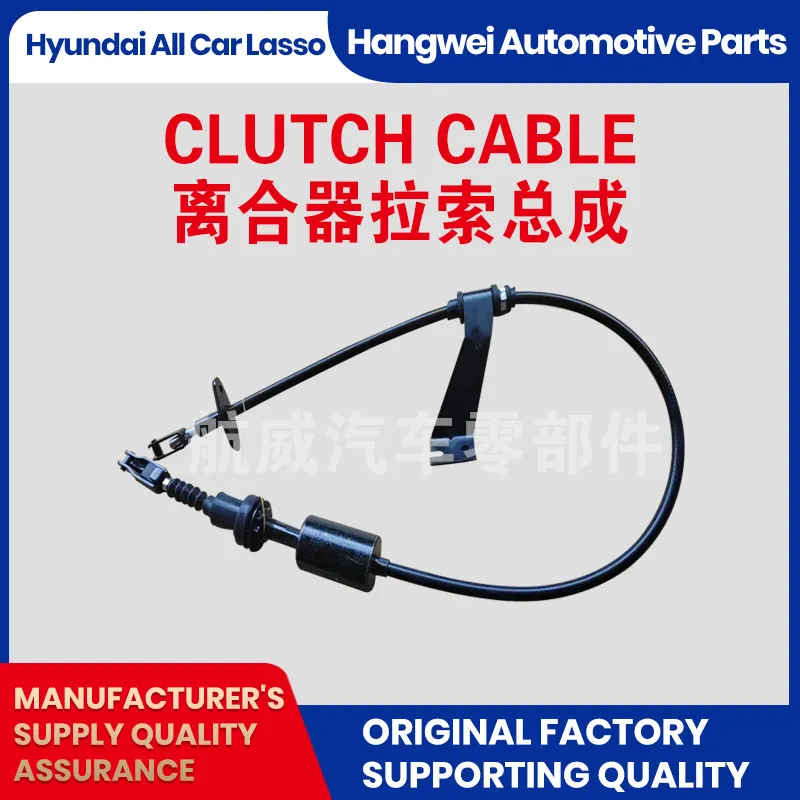Clutch Line: Durable, Leak-Free, Performance Upgrade
Clutch Push-Pull Cable: Field Notes, Specs, and What Buyers Keep Asking Me
If you’re evaluating a clutch line for motorcycles, light trucks, or off-road equipment, here’s the short version: the Clutch Push-Pull Cable from Qinghe (origin: Qinghe County Minjiang Street south, Wuzhishan Road east) has been quietly winning quotes because it balances cost with durability. In fact, many customers say the pedal feel stays stable longer than expected in coastal climates—always a pleasant surprise.
Industry trend check: hydraulics get the headlines, but cable-driven systems remain popular where simplicity, weight, and serviceability matter. Fleets love the quick swap, DIYers love the price, and OEMs like the packaging flexibility. To be honest, not every clutch line is built the same, and that’s where materials and testing make or break real-world life.

Image: Clutch Push-Pull Cable assembly, shown with weather boots and adjustable end.
What’s inside the cable (and why it matters)
The maker specifies a low-friction liner, spiral-wound steel conduit, and a 7×7 or 7×19 stainless or galvanized inner wire. That liner choice—often PTFE or PA12—reduces stick-slip and preserves consistent lever effort. End fittings are swaged with pull-out verification. I’ve seen fatigue rigs cycle these at elevated temperature to simulate urban stop-and-go—less glamorous than dyno runs, but brutally honest.
| Parameter | Typical spec (≈ / around) | Notes (real-world use may vary) |
|---|---|---|
| Inner wire | 7×7 or 7×19 stainless/galvanized, Ø1.5–2.5 mm | Pick based on load and bend cycles |
| Conduit | Steel spiral with PA12/HDPE cover | Corrosion-protected, abrasion-resistant |
| Liner | PTFE or low-friction polymer | Lower friction, smoother feel |
| Operating temp | -40 to +120 °C ≈ | Boots/grease spec affects limits |
| Pull-out strength | ≥ 2.5–3.5 kN | End fitting crimp validation |
| Service life | ≥ 150k–300k cycles | At rated load and temp, lab data |
| Corrosion test | 96–240 h salt spray | ISO 9227 / ASTM B117 methods |
| Certs | IATF 16949, ISO 9001, RoHS/REACH | Supplier system-level compliance |
Process flow and testing
Materials audit → wire drawing/stranding → liner extrusion → spiral conduit forming → end-fitting swage → adjuster assembly → 100% pull/length check → friction and return-force measurement → salt-fog/cycle benches → final audit. Testing standards referenced include IATF 16949 quality system, ISO 9227 salt spray, and ASTM B117 methodologies. Typical service life targets: 200k cycles at 25 °C, 150k cycles at 80 °C. Noise and harshness are screened with bend/return tests; I guess that’s why the squeaks we used to hear are rarer now.
Applications and feedback
Use cases: motorcycles, compact vans, light trucks, agricultural implements, forklifts, UTVs, and some marine throttles. A coastal taxi fleet reported 40% fewer clutch line replacements over 18 months; an OEM motorcycle program measured ≈12% lower lever force after switching to a PTFE-lined variant. Not every environment is so kind—mud, tight bends, and heat will still test any cable—but the consistency has been solid.
Customization menu
Lengths (±1 mm), end fittings (M6/M8 ball joints, clevises), adjustable barrels, protective boots, stainless vs. galvanized inner, pre-lube, color jackets, private label, and kitted hardware. Lead time is usually quick for standard ends; bespoke geometries take longer due to tooling.
Vendor snapshot: what you’re really comparing
| Vendor | Cycle life (lab) | Lead time | Customization | Certs | Indicative Cost |
|---|---|---|---|---|---|
| Qinghe Clutch Push-Pull Cable | ≈150k–300k | 2–4 weeks | High (ends/boots/length) | IATF 16949, ISO 9001, RoHS/REACH | Mid |
| Economy Aftermarket | ≈80k–150k | Stock–2 weeks | Low–Medium | ISO 9001 (varies) | Low |
| OEM Dealer Line | ≈200k+ | 2–6 weeks | Medium | IATF 16949 + OEM PPAP | High |
Bottom line: if you need a dependable clutch line with OEM-adjacent quality and room to customize, this one hits the value sweet spot.
Citations:
- IATF 16949:2016 – Automotive Quality Management System
- ISO 9227:2017 – Corrosion tests in artificial atmospheres (salt spray)
- ASTM B117 – Standard Practice for Operating Salt Spray (Fog) Apparatus
- REACH Regulation (EC) No. 1907/2006 – Registration, Evaluation, Authorisation and Restriction of Chemicals
- RoHS Directive 2011/65/EU – Restriction of Hazardous Substances
-
Clutch Line: Braided, Leak-Proof, OEM-Grade PerformanceNewsNov.10,2025
-
Throttle Cable: Durable, Smooth Control & Universal FitNewsNov.10,2025
-
Throttle Cable: Durable, Smooth, Universal Fit, Easy InstallNewsNov.10,2025
-
Clutch Line: Durable, Leak-Proof, OEM-Grade PerformanceNewsNov.10,2025
-
Hand Brake Cable | Custom, Universal & Trailer SolutionsNewsNov.10,2025
-
Clutch Line: High-Pressure, OEM-Fit, Corrosion-ResistantNewsNov.03,2025
